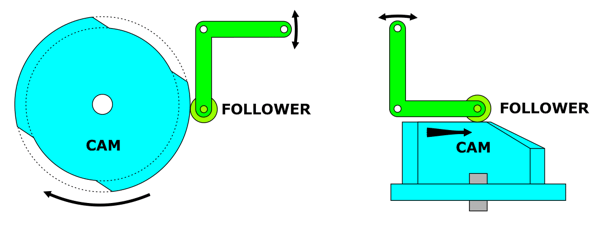Animation Fundamentals: Cams
This is one of the simplest yet most powerful principles one can employ in model animation. The term is likely most familiar owing to its importance in the function of internal combustion engines, but there's far more to it than that. A cam is simply an irregularly-shaped wheel, along which a follower rides; the motion of the follower sets a sequence of repeated motions into play. These motions can be quite complex, and a combination of multiple cams can create some incredibly sophisticated animation. Cams can also be used for electrical control; a player piano, which is simply a stack of multiple cams, is an example of how to create a complex sequence of electromechanical actions.
Typical Configurations

Above left, as the cam rotates, the follower moves back and forth. Whatever is being animated is attached to the other end of the follower. A follower isn't always necessary; a rod or link attached directly to the animated object can ride the cam; however, a follower is recommended to reduce the possibility of jamming due to friction.
Practical Application
The cam need not be the edge of the disc; above right, the cam is raised edge-wise on the side of the disc. This has the advantage of being a little more compact; it also changes the axis of the cam with respect to the follower. The photo below helps make this arrangement a little more clear; this is a gas station car lift.

